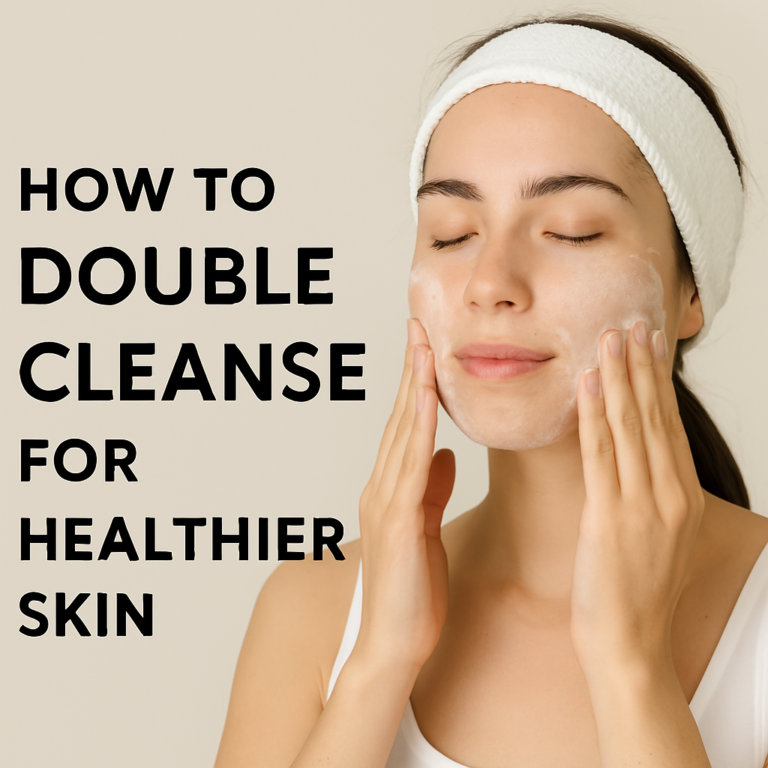What Is Double Cleansing and Should You Be Doing It?
Double cleansing isn’t just another skincare trend—it’s a technique rooted in science and tradition, especially popularized by Korean skincare. If you’ve ever struggled with breakouts, clogged pores, or persistent dullness, this method could transform your skin.
Let’s break down what double cleansing is, who it’s best for, how to do it correctly, and which mistakes to avoid.
What Is Double Cleansing?
Double cleansing is the method of cleansing your face twice, using two different types of cleansers:
- First Cleanser – Oil-Based:Removes oil-based impurities like makeup, sunscreen, excess sebum, and pollution.
- Second Cleanser – Water-Based:Removes sweat, dirt, and water-based debris while actually cleansing your skin.
This two-step process ensures your skin is completely clean without being stripped of its natural moisture barrier.
Why Is Double Cleansing Important?
Many skincare issues start with incomplete cleansing. If residue remains on your skin, your serums and moisturizers can’t absorb properly, leading to:
- Clogged pores
- Breakouts
- Premature aging
- Uneven texture
Double cleansing helps:
- Prevent acne and congestion
- Improve skin tone and clarity
- Boost the effectiveness of your skincare products
- Gently maintain your skin barrier
Who Should Double Cleanse?
While anyone can benefit, it’s especially ideal for:
- People who wear makeup or SPF daily
- Oily or acne-prone skin types
- Urban dwellers exposed to pollution
- Those using long-wear or waterproof products
- Anyone with dull, textured skin
If you have dry or sensitive skin, double cleansing may still work for you—just choose very gentle formulas and skip morning cleansing.
How to Double Cleanse Properly
Step 1: Oil-Based Cleanser
- Apply on dry skin.
- Massage gently for 1–2 minutes.
- Emulsify with warm water.
- Rinse thoroughly.
Look for:
- Mineral oil-free formulas
- Ingredients like jojoba oil, argan oil, or rice bran oil
Step 2: Water-Based Cleanser
- Use a gentle, low-pH cleanser.
- Massage on damp skin.
- Rinse with lukewarm water (avoid hot water).
Look for:
- Non-stripping surfactants
- Soothing ingredients like centella asiatica, green tea, or panthenol
When and How Often Should You Double Cleanse?
PM only. Double cleansing is typically done in the evening, especially if you wore sunscreen or makeup.
Avoid AM double cleansing unless your skin feels particularly oily or you had a sweaty workout.
For most skin types:
- Daily in the evening
- 3–5 times a week for sensitive or dry skin
Common Mistakes to Avoid
- Using harsh oil cleansers with essential oils that irritate sensitive skin
- Skipping the second cleanser, leaving residue behind
- Over-cleansing, which can dry out or sensitize skin
- Using high-pH foaming cleansers in step two
- Not emulsifying the oil properly before rinsing
Double Cleansing for Different Skin Types
| Skin Type | Recommendations |
|---|---|
| Oily/Acne-Prone | Lightweight oil + gel cleanser with salicylic acid |
| Dry/Sensitive | Creamy cleansing balm + milk or hydrating gel |
| Combination | Balancing oil + mild foaming cleanser |
| Mature | Nourishing cleansing oil + peptide or antioxidant-rich cleanser |
Is It OK to Just Use Micellar Water?
Micellar water may seem like a substitute for the first step, but it’s not oil-based and often doesn’t fully dissolve sunscreen or heavy makeup. It’s best used as a pre-step when no oil cleanser is available.
Our Product Picks (Optional Section)
If you’d like to explore double cleansing, try pairing these two:
- Oil-Based Cleanser: Banila Co Clean It Zero, DHC Deep Cleansing Oil, or The Ordinary Squalane Cleanser
- Water-Based Cleanser: CeraVe Hydrating Cleanser, Krave Matcha Hemp Cleanser, or La Roche-Posay Toleriane Hydrating Gentle Cleanser
Internal Links:
- How to Layer Skincare Products Correctly
- Best Moisturizers for Sensitive Skin
- The Role of Skin pH in Your Skincare Routine
- Skincare Mistakes That Cause Breakouts


